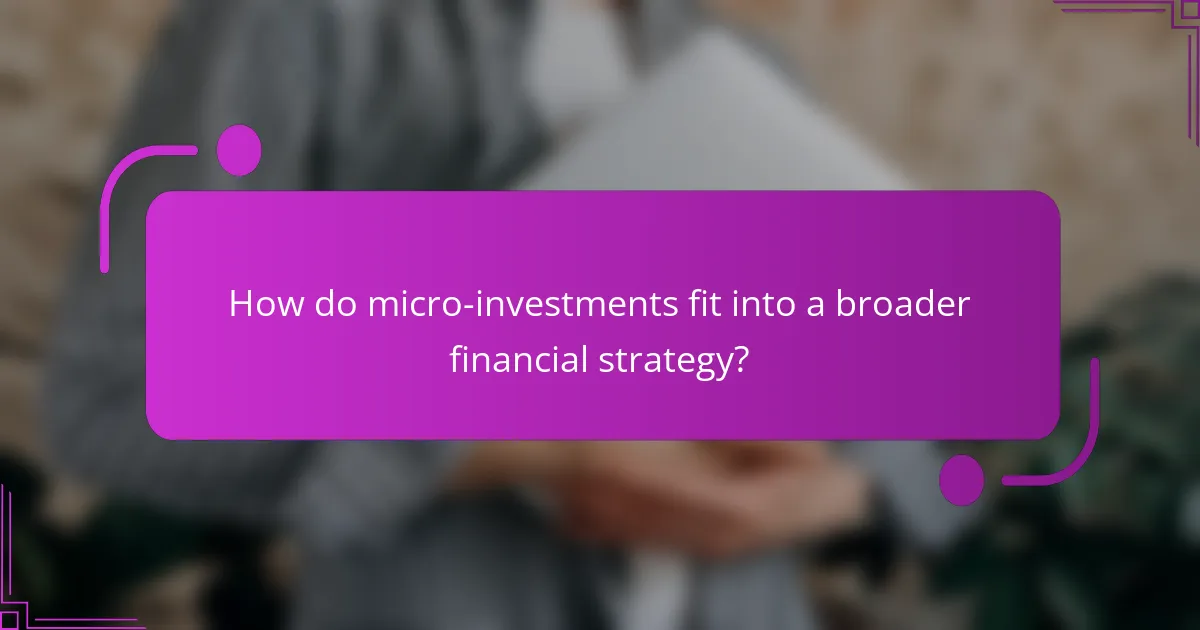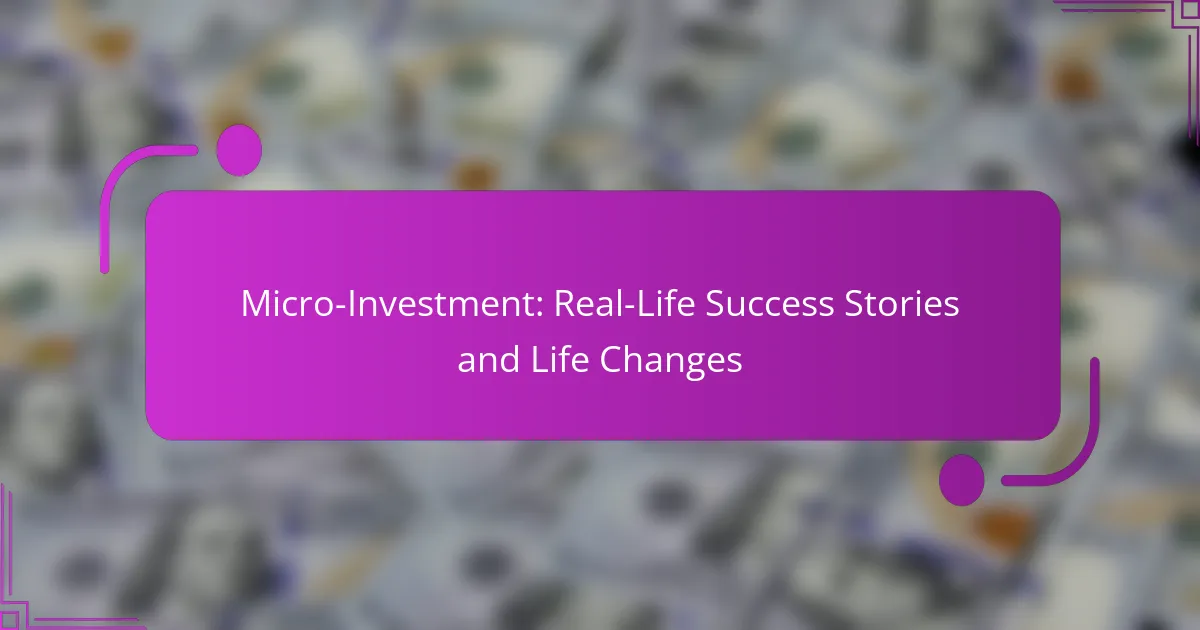Micro-investment has emerged as a powerful tool for financial empowerment, making investing accessible to individuals across various income levels. Through small, consistent contributions, many have transformed their financial futures, demonstrating that even minimal investments can lead to substantial growth over time. Real-life success stories showcase how these platforms enable users to invest spare change, fostering a culture of saving and investing that can significantly impact lives.

How can micro-investment change lives in the US?
Micro-investment can significantly change lives in the US by making investing accessible to everyone, regardless of income. By allowing individuals to invest small amounts of money, it promotes financial growth and empowers users to take control of their financial futures.
Increased financial literacy
Micro-investment platforms often provide educational resources that help users understand basic investment concepts. This increased financial literacy enables individuals to make informed decisions about their money, fostering a culture of financial awareness.
For example, many apps offer tutorials on stock market fundamentals, risk management, and portfolio diversification. This knowledge can lead to better financial choices and a more secure financial future.
Building a savings habit
Micro-investing encourages users to develop a consistent savings habit by allowing them to invest spare change or small amounts regularly. This approach can transform the way individuals view saving and investing, making it a part of their daily routine.
For instance, rounding up purchases to the nearest dollar and investing the difference can lead to significant savings over time. Users often find that these small contributions add up, helping them reach their financial goals without feeling the pinch.
Access to investment opportunities
Micro-investment platforms democratize access to investment opportunities that were once available only to wealthy individuals. Users can invest in diversified portfolios or fractional shares of stocks, which lowers the barrier to entry for many.
By starting with as little as $5 or $10, individuals can participate in the stock market and other investment vehicles. This accessibility allows more people to benefit from potential market gains and build wealth over time.

What are real-life success stories of micro-investment?
Real-life success stories of micro-investment illustrate how individuals have transformed their financial situations through small, consistent investments. These stories often highlight the accessibility and impact of platforms that allow users to invest spare change or small amounts regularly, leading to significant financial growth over time.
Acorns success story
Acorns has empowered many users to invest effortlessly by rounding up everyday purchases and investing the spare change. For instance, a user who regularly spends $10.50 on coffee might have Acorns round that up to $11, investing the extra 50 cents. Over time, these small contributions can accumulate into a substantial investment portfolio, with some users reporting growth in their accounts to several thousand dollars within a few years.
One notable success story involves a college student who started using Acorns with just $5 a week. By the time they graduated, their investment had grown significantly, providing a financial cushion for post-college life. This demonstrates how even minimal investments can lead to meaningful financial changes.
Stash user testimonials
Stash users often share testimonials about how the platform has helped them take control of their finances. One user mentioned starting with just $10 a week, which allowed them to build a diversified portfolio over time. They appreciated the educational resources Stash provided, which helped them understand investment strategies and make informed decisions.
Another user highlighted the importance of setting financial goals within Stash. By defining specific targets, such as saving for a vacation or a new car, they were able to stay motivated and track their progress. This approach not only made investing feel more achievable but also encouraged consistent contributions.
Robinhood investment journeys
Robinhood has become popular for its commission-free trading, attracting many new investors. Users have shared stories of starting with small amounts, such as $50, and gradually increasing their investments as they gained confidence. One user reported turning a $100 investment into a $1,000 portfolio by actively trading and learning from their experiences.
However, some users caution against the risks associated with trading on Robinhood. They advise new investors to start small and focus on long-term strategies rather than attempting to make quick profits. This balanced approach can help mitigate losses while still allowing for growth in their investment journeys.

What platforms facilitate micro-investment?
Several platforms enable micro-investment, allowing users to invest small amounts of money easily. These platforms often focus on user-friendly interfaces and automated investment strategies to help individuals grow their savings over time.
Acorns overview
Acorns is a popular micro-investment platform that rounds up users’ purchases to the nearest dollar and invests the spare change. For example, if you buy a coffee for $2.75, Acorns will round it up to $3.00 and invest the $0.25 difference.
Users can choose from various investment portfolios based on their risk tolerance, and Acorns charges a monthly fee, typically around $1 for accounts under $1 million. This makes it accessible for beginners looking to start investing without large sums of money.
Stash features
Stash allows users to invest in fractional shares of stocks and ETFs, making it easy to build a diversified portfolio with minimal funds. Users can start investing with as little as $5, which is ideal for those new to investing.
Stash also offers educational resources to help users understand investing concepts, along with personalized investment recommendations. The platform has a monthly fee structure, starting at $1, which can be a consideration for users with very small investment amounts.
Robinhood benefits
Robinhood is known for its commission-free trading, allowing users to buy and sell stocks, ETFs, and cryptocurrencies without incurring fees. This feature makes it attractive for micro-investors looking to maximize their returns on small investments.
The platform offers a user-friendly mobile app and allows users to invest in fractional shares, making it easier to diversify their portfolios. However, users should be aware of potential risks, as trading can be more volatile than traditional investing methods.

How to choose a micro-investment platform?
Choosing a micro-investment platform involves evaluating key factors such as fees, user experience, and available investment options. Prioritize platforms that align with your financial goals and offer a seamless experience for investing small amounts.
Fees and costs comparison
When comparing micro-investment platforms, look closely at the fees associated with each option. Many platforms charge a percentage of your investment, while others may have flat fees or account maintenance costs. Aim for platforms with low fees, ideally under 1% of your investment.
For example, some platforms may charge a monthly fee of around $1 to $3, while others might take a small percentage of your returns. Always calculate how these fees will impact your overall investment growth over time.
User experience evaluation
User experience is crucial when selecting a micro-investment platform. A well-designed interface can make it easier to manage your investments and track progress. Look for platforms that offer intuitive navigation, clear information, and responsive customer support.
Consider reading user reviews and testing platforms through demo accounts if available. This can help you gauge how user-friendly the platform is and whether it meets your needs for managing small investments.
Investment options available
The variety of investment options is another important factor in choosing a micro-investment platform. Some platforms may focus on stocks and ETFs, while others might offer bonds or real estate investments. Ensure the platform provides options that align with your investment strategy.
For instance, if you are interested in socially responsible investing, look for platforms that offer ESG (Environmental, Social, and Governance) investment options. A diverse range of choices can help you build a balanced portfolio, even with small amounts of capital.

What are the risks of micro-investment?
Micro-investment carries several risks that potential investors should consider before committing their funds. These risks include market volatility, limited growth potential, and gaps in investment knowledge that can affect decision-making.
Market volatility impact
Market volatility can significantly influence micro-investment outcomes. Small investments are often more susceptible to price fluctuations, which can lead to rapid gains or losses. Investors should be prepared for the possibility of losing their initial investment, especially in turbulent market conditions.
To mitigate the impact of volatility, consider diversifying your micro-investments across various sectors or asset classes. This strategy can help cushion against sharp declines in any single investment, providing a more stable overall portfolio performance.
Limited growth potential
Micro-investments typically offer limited growth potential compared to larger investments. Since the amounts invested are small, the returns may not be substantial enough to significantly impact overall wealth. Investors should set realistic expectations regarding the returns they can achieve.
For example, while investing small amounts in high-growth startups might yield impressive returns, the likelihood of failure is also higher. Balancing micro-investments with more traditional investment strategies can help achieve better long-term growth.
Investment knowledge gaps
A lack of investment knowledge can pose a significant risk for micro-investors. Many individuals may not fully understand the assets they are investing in or the market dynamics at play. This knowledge gap can lead to poor investment choices and missed opportunities.
To address this issue, investors should educate themselves about the basics of investing, including how to analyze potential investments and understand market trends. Utilizing resources such as online courses, investment apps with educational content, or financial advisors can enhance knowledge and improve investment outcomes.

How do micro-investments fit into a broader financial strategy?
Micro-investments are small, manageable investments that can significantly enhance a broader financial strategy. By allowing individuals to invest spare change or small amounts regularly, they help build wealth over time while complementing other investment vehicles.
Complementing retirement accounts
Micro-investments can serve as an excellent supplement to traditional retirement accounts like 401(k)s or IRAs. While retirement accounts often require larger contributions, micro-investing allows you to consistently add to your savings without straining your budget.
For example, if you regularly invest small amounts through a micro-investing app, these contributions can accumulate and provide additional funds for retirement, enhancing your overall financial security.
Diversifying investment portfolio
Incorporating micro-investments into your financial strategy can help diversify your investment portfolio. By spreading small amounts across various assets, you reduce risk and increase the potential for returns.
Consider allocating micro-investments into different sectors or asset classes, such as stocks, bonds, or real estate. This approach allows you to explore new investment opportunities without committing significant capital.
Short-term vs long-term goals
Micro-investments can effectively address both short-term and long-term financial goals. For short-term objectives, such as saving for a vacation or a new gadget, you can accumulate funds quickly through regular micro-investing.
For long-term goals, like retirement or purchasing a home, the power of compounding can turn small, consistent investments into substantial savings over time. Aim to set clear goals and timelines to maximize the effectiveness of your micro-investment strategy.



